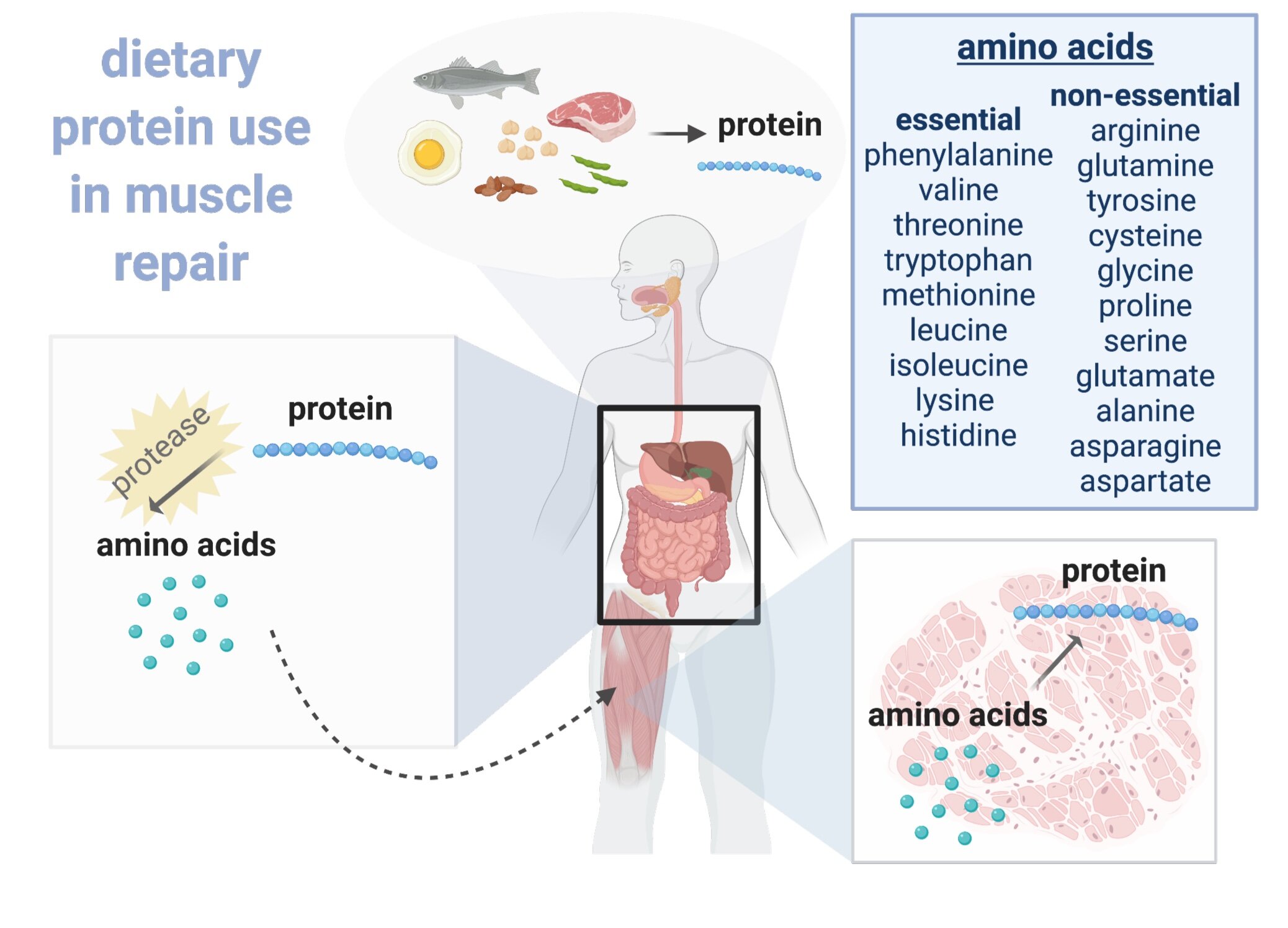All About Protein (and Protein Powder)
Protein digestion
Proteins are made up of the building blocks amino acids. When we eat protein, whether that be protein powder in a smoothie or from a juicy burger, our bodies break down and digest dietary protein into amino acids. These amino acids are then used to build the specific proteins needed in our bodies. Proteins are not only important for muscle synthesis and repair, but for every function that occurs in our body. Proteins are responsible for carrying out all the biological pathways in our body, thus it’s important to make sure we are consuming enough.
Protein digestion occurs in the stomach and intestine, where proteases and stomach acid breakdown proteins into smaller peptides and eventually their building blocks, amino acids. There are 20 unique amino acids that make up the proteins we both consume and build in our body, carrying out the tasks our cells need to maintain themselves. Our body can synthesize some of these amino acids on its own (called non-essential amino acids), however, we need to supplement through our diets the ones we are unable to build (called essential amino acids).
Protein Needs
Essential amino acids are the 9 amino acids our body cannot synthesize and thus we must get from our diet. Do you need a supplement to meet your needs? Remember, many foods include protein, not just meat and eggs. Legumes, grains, dairy, and even vegetables all have protein, and the little bits here and there add up over the course of a day. Needs vary based on activity level, age, health status, and other factors. The RDA for protein intake is 0.8 g/kg body weight per day, however, needs of active individuals increase to 1.2-1.6 g/kg per day. A registered dietitian can assess your needs, determine if you are meeting your needs, and if necessary, help you figure out how to incorporate more protein into your meals and snacks.
How to choose a protein powder?
If you find you aren’t meeting your needs through your diet, adding protein powder to a shake or smoothie is an easy way to ramp up your protein intake. Protein powders are a convenient and easy way to add extra protein to your diet, whether you're looking to build muscle, recover from a workout, or simply boost your overall protein intake. How do you choose a protein powder? I recommend choosing one that is a complete source of essential amino acids. I personally like unflavored whey protein in my smoothies, but it’s all about personal preference. There are many options out there for flavored whey, pea, and soy protein powders. Key factors to keep in mind are the other added ingredients. Do you need your protein powder to have a little fat in it too, or will you be pairing it with a fat source in your smoothie (such as a nut butter) and prefer it to be fat free or low in fat. Same goes for sugar; added sugars are often found in flavored protein powders, so unless you are using it with this goal in mind (for example, sugar post workout to replete your glycogen stores), try to minimize added sugar in your protein powder and let the other ingredients of your smoothie do the sweetening to your liking.
Since during protein digestion, your chosen protein supplement is broken down into amino acids and used to build new proteins, if you add a scoop of collagen peptides to your smoothie, it’s likely not going to help your skin any better than an alternative protein source which may be collagen, but can be anything the body needs. Collagen is missing one essential amino acid, tryptophan, so is not even a complete protein source compared to whey, pea, or soy protein supplements.
With so many options on the market, it can be overwhelming to try and figure out which protein powder is best for you. Here are a few things to consider when selecting a protein powder:
Type of protein: There are several types of protein powders available, including whey, casein, soy, pea, and hemp. Each type of protein has its own unique benefits and drawbacks, so it's important to consider which one is best for your needs. For example, whey protein is a fast-acting protein that is easily absorbed by the body, making it a good choice for post-workout recovery, and flavor wise is often more easily disguised in smoothies and oatmeal compared to pea protein.
Flavor and sweetness: Protein powders come in a variety of flavors, from chocolate and vanilla to strawberry and beyond. For most versatility, choose a neutral flavor, such as unflavored or vanilla. Additionally, consider the level of sweetness in the protein powder. Aim for less than 8 grams of sugar per serving (unflavored will have 0 grams, and some will be artificially sweetened with 0 grams).
Quality and purity: When choosing a protein powder, it's important to look for high-quality, pure ingredients. Always buy third-party tested protein powders and avoid protein powders.
Price: Protein powders can range in price from under $10 to over $50 per container. More expensive doesn’t always mean higher quality. I personally buy generic brand unflavored whey protein powder (usually whatever is on sale) and mix it into smoothies, chia pudding, or waffle mix and add my own flavoring agents.

